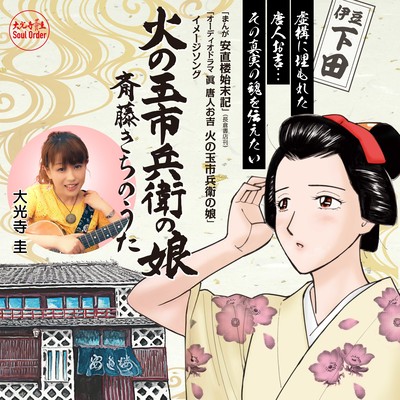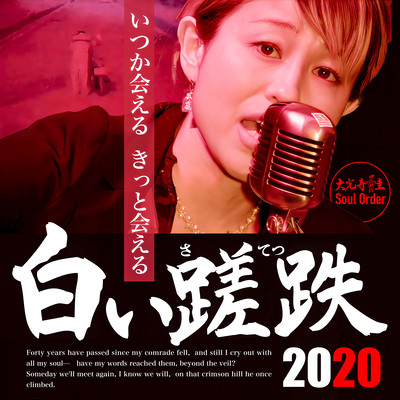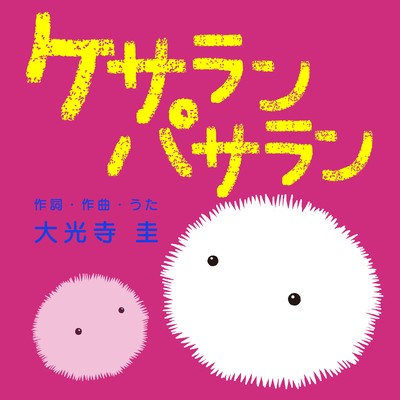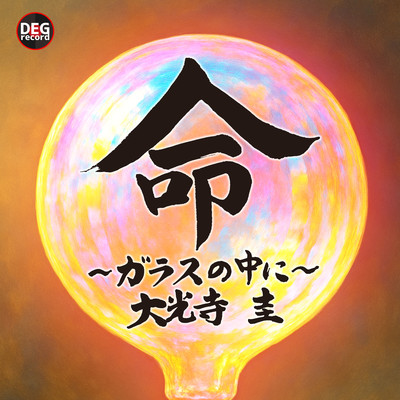

きいておくれよ ワチキのはなし
勝手なことばっかり 言うんじゃないよ
芸のためやら お國のためと
自分のためなど 一度とて
生きたことなどないけれど
苦労だなんて 思わない
ワチキだから できたのさ
悲しむことなど ありゃしない
だって ワチキは 火の玉市兵衛の娘
下田一の 船大工の娘さ
下田一の 芸者になるのは
当たり前ってもんさ
だって ワチキは 市兵衛 自慢の娘
下田一の男気に あふれた
その魂 受け継いだ 娘なのさ
知っているかい ワチキの子ども
もらい子だって 可愛い我が子
朝から晩まで 働きずくめ
大盛況さ 安直楼は
疲れる暇さえ ありゃしない
だけど ちっとも 辛かない
守るものに 守られて
羨むことなど ありゃしない
だってワチキは 火の玉市兵衛の娘
下田一の 情深い男さ
結んだ縁を つないでゆくのは
当たり前ってもんさ
だって ワチキは 市兵衛 自慢の娘
我が子のため 働く 喜びを
与えてもらった 幸せな 女なんだ
そうさ ワチキは 火の玉市兵衛の娘
人に何と 言われようが かまわない
いずれわかるさ 魂は 永遠だから
- Lyricist
Takeshi Sugimoto
- Composer
Kei Daikouji
- Producer
digitake.com
- Recording Engineer
Seiki Aizawa
- Mixing Engineer
Horoki Inoue
- Mastering Engineer
Horoki Inoue
- Graphic Design
digitake.com, Kei Daikouji, Hiroyuki Araki
- Guitar
Kei Daikouji, Masatoshi Hagowara
- Bass Guitar
Koudai Kodama
- Drums
Horoki Inoue
- Vocals
Kei Daikouji
- Piano
Kazumi Hagowara
- Harmonica
Tomomi Shimoda

Listen to Kichi Saito: The True Story of Tojin Okichi by Kei Daikouji
Streaming / Download
- ⚫︎
Kichi Saito: The True Story of Tojin Okichi
Kei Daikouji
In the early Showa era, the story of Tojin Okichi became a nationwide sensation in Japan.
Set in Shimoda, Izu, shortly after Japan opened its ports to the world, the tale depicts Okichi as a geisha who catches the eye of Townsend Harris, the first American Consul General to Japan.
She is separated from her fiancé and begins visiting Gyokusenji Temple, which had been converted into the consulate.
Although the villagers initially sympathize with her, their attitudes shift dramatically when they learn that she is receiving a large sum of money.
They begin to scorn her, calling her Tojin, and heartbroken, Okichi is said to have thrown herself into the Inouzawa River.
This tragic narrative has long been passed down through generations.
However, historical evidence suggests that much of this story is fictional, likely created during a time when anti-American sentiment was on the rise before World War II.
The real woman on whom the story is based, Kichi Saito, is indeed recorded to have visited Gyokusenji.
Later, she married and lived in Yokohama, and after returning to Shimoda, she worked independently as a hairdresser skilled in creating the Tojin Mage hairstyle, which was popular at the time and had originated in Yokohama, a center of new culture.
The nickname Tojin Okichi was not a term of ridicule, but rather a reference to her unique skill in this particular style.
Moreover, Kichi went on to manage a small eatery called Anchokuro, where she adopted and raised two children, living a modest yet dignified life.
The song Hinotama Ichibei no Musume Saito Kichi no Uta was written to portray the true and resilient image of Kichi Saito.
It serves as the theme song for a number of works inspired by the non-fiction book The Men Who Created Tojin Okichi, written by Takeshi Sugimoto and published by Nagakura Shoten.
These include the 2018 biographical manga Manga Anchokuro Shimatsuki, written by Sugimoto and illustrated by Hiroyuki Araki, as well as the audio drama Shin Tojin Okichi Hinotama Ichibei no Musume, currently available on YouTube, featuring the voice of Reiko Ikeda as Okichi.
The audio drama Shin Tojin Okichi Hinotama Ichibei no Musume is freely available to watch.
If you are interested in discovering the true story of Kichi Saito, we highly recommend giving it a listen.
Artist Profile
Kei Daikouji
Born on November 2, 1979. Kei Daikouji is a singer-songwriter from Ayase City in Kanagawa Prefecture, Japan. She made her indie debut in 2005 with the single Peach Moon, followed by her major debut in 2006 with the maxi single Machiawase o Shimashou (Let Us Meet). Before launching her solo career, she was active as the guitarist and vocalist of the all-female band Ramune, which disbanded in April 2004. In 2009, her song Watashi no Suiheisen (My Horizon) was featured as the ending theme of the Fuji TV program Lion no Gokigenyou, gaining nationwide recognition. Alongside her music career, she works as a nurse and holds a sixth-degree master certification in Japanese calligraphy, showing her diverse talents. Currently, she is based in her hometown of Ayase, where she continues to write and perform music while contributing to her community through her work as a nurse. She also serves as the executive committee chair of the Ayase Music Festival, an annual event held every September that promotes community building through music. Additionally, she is providing original songs for the Ayase Civic Musical Kesaran Pasaran, which is scheduled to be performed in December 2025 at the Ayase City Owens Cultural Hall. Through this project, she continues to support and promote local cultural initiatives.
Kei Daikoujiの他のリリース
PBC-network








